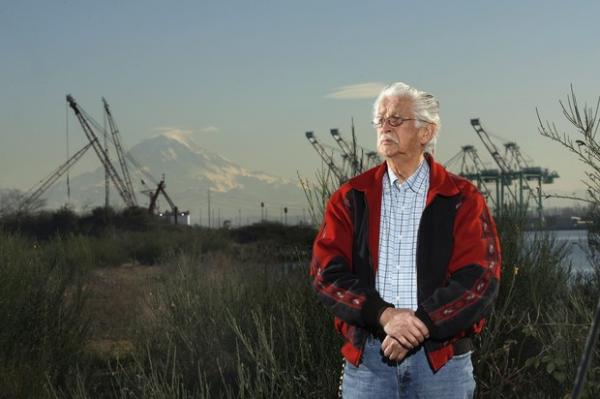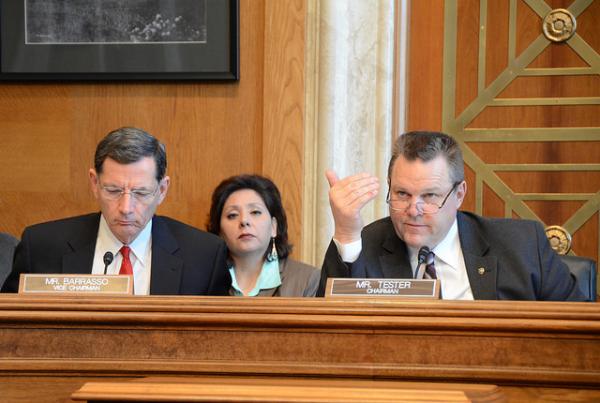Author: Kim Kalliber
Melissa Lee Bradford
$15 Wage Wins in Seattle: ‘We Did This. Workers Did This.’
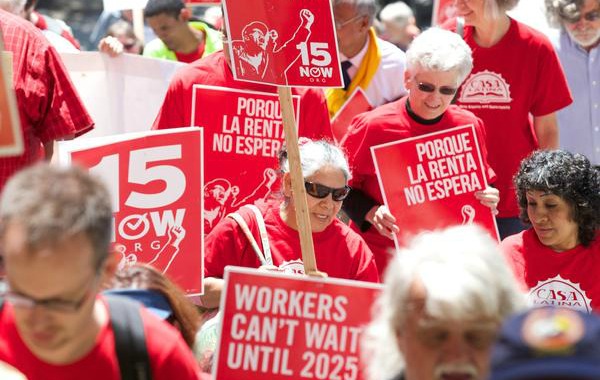
In historic and unanimous vote, city to give make its work force highest paid in the nation
By Jon Queally, Common Dreams
Less than six months after the start of an aggressive grassroots campaign, the Seattle City Council unanimously approved a $15 minimum wage on Monday, the highest in the nation.

A supporter of the $15 an hour minimum wage holds a sign during a Seattle City Council meeting in which the council voted to raise the minimum wage in Seattle, Monday June 2, 2014. (Photo: Stephen Brashear / Puget Sound Business Journal) The measure passed by a 9-0 vote and was met with cheers and celebration among workers in the chamber and those gathered outside.
“We did this. Workers did this. Today’s first victory for 15 will inspire people all over the nation,” said councilor Kshama Sawant, whose victory last fall as a Socialist Alternative candidate and continued push for the $15 wage are credited with galvanizing the city-wide movement that pushed the council for the increase.
“A hundred thousand low-wage workers in Seattle will be seeing their wages raised to $15 an hour over the next 10 years. That would imply a transfer of roughly $3 billion from the top to the lowest paid workers,” she continued. “Such a transfer has not happened in so many decades because mostly what’s happened is the flow of wealth has been from the bottom up. This is really raising the confidence of working people around the country.”
“We did this. Workers did this. Today’s first victory for 15 will inspire people all over the nation.” —Kshama Sawant, city councilor
Working Washington—a coalition of individuals, neighborhood associations, immigrant groups, civil rights organizations, people of faith, and labor—also celebrated the victory. In a statement just ahead of the vote, the group said:
When Seattle fast food workers with Working Washington first called for $15, many thought it was well out of reach — an impossible dream, not a realistic demand. But the bold leadership of fast food workers, airport workers, grocery workers, and others transformed the public debate and changed what was possible.
A year ago, $15 was just a number on fast food strikers’ picket signs. Today it’s set to become reality for 100,000 Seattle workers.
It was not a complete and total victory for progressive coalition. Numerous amendments offered by Sawant to strengthen the new wage law, including speeding up its implementation, were defeated by the council. In the end, however, no one denied that it was only the relentless pressure from below that forced its historic, if compromised, passage.
In her speech following the vote, Sawant acknowledged the shortcomings of the bill, but called it an “historic victory” as she rose to explain the importance of how Seattle activists were able to bend the council, including those tied to large business interests, towards their will:
15 was not won at the bargaining table as the so-called “sensible compromise” between workers and business. It was not the result of the generosity of corporations or their Democratic Party representatives in government.
What was voted on in the city council was a reflection of what workers won on the street over this last year.
In 15 Now, groups of workers and activists met weekly, held mass conferences and debates, organized rallies, and engaged thousands of people around the city about the need for a living wage. We won the public debate – in a recent poll 74% of voters now support 15. We defeated the arguments of business in the corporate media.
Let this be our guide. At every stage of the struggle, corporations and their representatives, have sought to undermine our efforts. And future victories will also depend on the organization of working people fighting for our interests.
Writing for The Nation, John Nichols highlighted the aggressive stance of Sawant and her allies as he put the Seattle wage fight in its national context:
Sawant unsuccessfully proposed amendments to speed up wage hikes for employees of the largest businesses—those with over 500 employees—and to assure that tipped workers get the full benefit of the wage hike. And she objected to a provision that allows for paying some workers below the minimum, saying, “Any kind of teenage wage or sub-minimum wage goes against the principles of workers standing together. The sub-minimum wage is demanded and liked by businesses because it allows them to bring down wages in general. It’s harmful for workers as a whole.”
Sawant and her allies are not done with the fight. They are gathering signatures for a city charter amendment that would have large businesses paying $15-an-hour starting January 1, 2015, while small business and nonprofits would have a three-year phase-in period. The charter amendment will, if it qualifies for the ballot, face significant opposition from Big Business. And there will be those who suggest that the 15 Now activists are asking for more than can be reasonably obtained.
But just a year ago, there were plenty of folks who said $9-an-hour was an unreasonable goal. Now the debate in Seattle is about how quickly to go to $15. And that debate is spreading to communities nationwide.
In response to passage of the new Seattle wage hike, the International Franchise Association—which represents corporate chain stores and restaurants like McDonald’s, Subway, and others—renewed their promise to sue the city over the new wage law. But as the Seattle Times reports, many local business owners welcomed the vote:
Molly Moon Neitzel, owner of Molly Moon’s ice cream, said the mandate will drive up her labor costs by $100,000 a year, but she expects to benefit from workers with more money to spend locally.
“A hundred thousand people next year will have more money in their pockets,” she said, referring to the estimated number of workers who now make less than $15. “They’ll have more money to buy ice cream.”
Neitzel has about 80 employees at six stores in Seattle. Last fall, she raised pay for her non-tipped employees to $15 from between $11 and $13.50.
She said another probable benefit from the higher minimum wage is reduced employee turnover.
“They’re so appreciative of the raise,” she said of her non-tipped employees. “Retention is great, and their quality of life has increased.”
‘The cause is us’: world on verge of sixth extinction

Species loss soaring at ‘pace not seen in tens of millions of years’
By Andrea Germanos, May 30, 2014. Source: Common Dreams
A new study showing that the human activity has driven current rates of species extinction to 1,000 times faster than the natural rate is “alarming” and “should be a clarion call” to work towards greater conservation efforts, an environmental group charges.
The study, published Thursday by the journal Science and led by conservation expert Stuart Pimm, also warns that without drastic action, the sixth mass extinction could be imminent.
From habitat loss to invasive species to climate change to overfishing, humans are contributing to the plummet in biodiversity.
“This important study confirms that species are going extinct at a pace not seen in tens of millions of years, and unlike past extinction events, the cause is us,” stated Noah Greenwald, endangered species director with the Center for Biological Diversity, who was not involved in the study.
While new technology like smart phone apps and crowd-sourcing have increased the amount of data collected on species, much still remains a mystery.
“Most species remain unknown to science, and they likely face greater threats than the ones we do know,” Pimm said in a statement.
“The gap between what we know and don’t know about Earth’s biodiversity is still tremendous,” added study co-author Lucas N. Joppa, a conservation scientist at Microsoft’s Computational Science Laboratory in Cambridge, UK, “but technology is going to play a major role in closing it and helping us conserve biodiversity more intelligently and efficiently.”
While the study illustrates a dramatic pace in biodiversity loss, Greenwald emphasized that it also highlights the successes of conservation efforts, such as the 50-year-old Wilderness Act and the Endangered Species Act.
“Were it not for the huge effort over the past 50 years to protect wilderness, we would have had a 20 percent higher extinction rate,” Greenwald told Common Dreams. “Protecting places, standing up for places, leaving some places untouched does make a difference,” he said.
As for what people can do to help those conservation efforts, Greenwald said people should let their legislators know that they support protecting areas as wilderness or parks, “because that is really what this study shows” — that the conservation laws and efforts over the past several decades have helped thwart further losses.
“The findings of this study are alarming to say the least,” Greenwald’s statement continues. “But it also shows we can make a difference if we choose to and should be a clarion call to take action to protect more habitat for species besides our own and to check our own population growth and consumption.”
As Greenwald said, the cause of the problem is us, but the solution, too, lies with us.
“We are on the verge of the sixth extinction,” Pimm told the Associated Press. “Whether we avoid it or not will depend on our actions.”
Longtime Puyallup Tribal Leader Herman Dillon Sr. Walks On
Elected to the Puyallup tribal council in 1971, Herman Dillon Sr. was a “tireless advocate for the social and economic betterment” of his tribe and tribes throughout the Northwest, Gov. Jay Inslee told The Seattle Times. Dillon walked on May 23, 2014 at the age of 82.
“Our whole family is grieving the loss of the head of our family,” his daughter Sheila Beckett told the Times. “We appreciate everyone’s condolences during this rough time. He was so important to all of us. He will be greatly missed.”
Dillon not only served on the Puyallup City Council for more than 35 years, but he also testified on Indian affairs in Washington, D.C., and supported treaty fishing and hunting rights. Dillon was a longtime friend of Nisqually activist Billy Frank Jr., who walked on May 5 at the age of 83.
RELATED: Billy Frank Jr., 1931-2014: ‘A Giant’ Will Be Missed
“This is a sad day,” John Weymer, a spokesman for the tribe and Dillon’s personal friend told The News Tribune. “He’s had heart issues for years, but it still came as a surprise because he had been doing better for a while.”
During Dillon’s time leading the tribal council, the tribe went from poverty to prosperity, in large part due to casino gaming. He helped negotiate compacts with Washington State, and membership in the tribe more than tripled during his leadership, reports The News Tribune.
In a statement, Tacoma Mayor Marilyn Strickland called Dillon “a constant and reliable leader for the tribe and the region.”
A public memorial service was held May 31 for Dillon—The News Tribune published a photo gallery of the service here.
Read more at http://indiancountrytodaymedianetwork.com/2014/06/03/longtime-puyallup-tribal-leader-herman-dillon-sr-walks-155124
Not Separate, Not Equal: Feds Look at Native Kids in Public Schools
The federal government recently took a look at how American Indian children are faring in public schools—and the results are disturbing.
Minority children in public schools are generally subjected to harsher, more frequent disciplinary measures than are white students, according to the report, “School Discipline, Restraint, & Seclusion,” released by the U.S. Department of Education Office for Civil Rights. The data collection that served as the basis of the report covered all 97,000 public schools in the U.S., which serve 49 million pre-K through grade 12 students. Between 90 percent and 95 percent of American Indian and Alaska Native children are educated in public schools.
“The issue of unlawful racial discrimination in school discipline is… a civil rights issue,” states a U.S. Department of Education spokesperson. “Title VI protects students from discrimination based on race in connection with all academic, educational, extracurricular, athletic, and other programs and activities of a school, including programs and activities a school administers to ensure and maintain school safety and student discipline.
A few examples of the government’s findings: AI/AN children, who represented 0.5 percent of enrollment of the schools included in this calculation, accounted for 2 percent of single and multiple out-of-school suspensions and 3 percent of expulsions. On the other hand, they accounted for only 0.2 percent of in-school suspensions. By contrast, white students, who accounted for 51 percent of enrollment, comprised 40 percent of in-school suspensions, 36 percent and 31 percent of single and multiple out-of-school suspensions respectively and 36 percent of expulsions. These numbers suggest that the harsher the punishment (with in-school suspension at one end of the scale and expulsion at the other), the less likely is it to be applied to white students and the more likely it is to be imposed on AI/AN children.
Thirteen percent of AI/AN boys received out-of-school suspension, compared with 6 percent of white boys. Seven percent of AI/AN girls received out-of-school suspension, compared with just 2 percent of white girls.
More than twice as many students with disabilities received out-of-school suspensions (13 percent) than did non-disabled students (6 percent). A whopping 29 percent of AI/AN boys with disabilities received out-of-school suspensions, compared with 12 percent of white boys. Twenty percent of AI/AN girls with disabilities received out-of-school suspensions, compared with 6 percent of white girls with disabilities.
“The administration of student discipline can result in unlawful discrimination based on race in two ways: first, if a student is subjected to different treatment in discipline based on the student’s race, and second, if a discipline policy is neutral on its face—meaning that the policy itself does not mention race—and is administered in an evenhanded manner but has a disparate impact, i.e., a disproportionate and unjustified effect on students of a particular race,” explained the spokesperson.
The Office for Civil Rights can investigate potential violations if the data warrants. “The data showing disproportionalities by race and ethnicity provide a basis for OCR to investigate further, including all relevant circumstances, such as the facts surrounding a student’s actions and the discipline imposed, to determine whether there was discrimination.” For example, a September 2012 investigation of Oakland, California schools resulted in a “voluntary resolution agreement [that] addressed issues of whether African American students were disciplined more frequently and more harshly than white students,” says the department spokesperson.
A Senate Committee on Indian Affairs oversight hearing titled “Indian Education Series: Indian Students in Public Schools—Cultivating the Next Generation,” also found areas of concern, particularly in relation to Impact Aid.
William Mendoza, executive director of the White House Initiative on AI/AN Education, noted that the Office for Civil Rights report found other discrepancies in the education of AI/AN kids. For example, American Indian kindergarteners repeat the grade at nearly twice the rate of white children, AI/AN students go to schools with more first-year teachers than do white students and AI/AN students have the highest dropout rate of any racial or ethnic population, with a graduation rate of just 68 percent, compared with 75 percent for all students.
Mendoza testified that Impact Aid to help fund education for schools in districts with untaxable federal lands was funded at copy.2 billion for FY 2014, with half of that money going to public schools that educate children living on Indian lands.
Brent D. Gish, executive director of the National Indian Impacted Schools Association, put that number in perspective. While the Impact Aid program was established by Congress in 1950, it has not been fully funded since 1969. According to Dan Hudson, Wyoming State Impact Aid chairman and assistant superintendent of Fremont County School District #14, the Basic Support component of Impact Aid is currently funded at only 58 percent of authorization while the Payments for Property component is funded at just 3.5 percent of authorization.
Gish also noted that the Impact Aid program is not forward-funded, presenting challenges for planning and hiring. The 2013 federal sequester added to those challenges. “The sequester hit federally impacted Indian land school districts hard and to the detriment of the students, their communities and reservations,” he testified.
RELATED: Every Child Left Behind: Sequester Guts Indian Education, Part 3
But there is good news too, as a number of panelists testified. For example, Alberto Siqueiros, superintendent of the Tohono O’odham Nation’s Baboquivari Unified School District, told the committee how his school district is in the process of completely transforming itself from a mediocre educational endeavor into an excelling school district by putting everything—from teacher hiring to community involvement and expectations for both faculty and kids—on the table.
“Long gone are the days of low expectations, mediocre performance and results often seen in tribal educational settings. We insist that the entire BUSD community support our efforts in educating our children,” he said. The results so far include a nearly 40 percent increase in graduation rates in the past five years, six Gates Millennium Scholars and one Dorrance Scholar in the past three years and over $2 million in scholarships in 2013. In that year, 52 seniors graduated, 30 applied to college, 24 were accepted and 19 enrolled in college.
Read more at http://indiancountrytodaymedianetwork.com/2014/06/03/not-separate-not-equal-feds-look-native-kids-public-schools-155085?page=0%2C2
Lamprey Fishing Blessing Ceremony Has Tribal Sovereignty Undertone
By Tom Banse, NW News Network
For centuries, Native Americans from Boise to Wenatchee to the southern Oregon coast have harvested Pacific lamprey, colloquially called eels. The ugly-looking critter resembles an eel, but it is actually a primitive fish with a distinctive, toothy suction cup mouth.
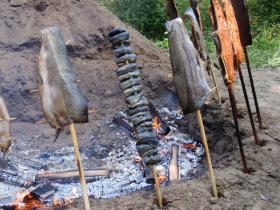
Willamette Falls, just outside Portland, is one of the few remaining places in the Northwest where it is possible — and legal — to catch Pacific lamprey for personal and ceremonial use. Tribal members are about the only ones who go for it.
During a “blessing ceremony” for lamprey and fishermen held at the confluence of the Willamette and Clackamas Rivers Monday, tribal schoolchildren led an eel dance, a sort of snaking Conga line more than 50 strong of all ages.
One of the fishermen there, Patrick Luke, is a Yakama Nation biologist. Luke is still miffed about the ticket he received from Oregon Fish and Wildlife police at the nearby falls in 2011.
“Now they have got folks on the reservation that won’t even come down here because they are afraid that enforcement will intimidate folks like they did in the past,” Luke said. “I grew up living that way in the 1970s seeing the state policemen treat the Indian folks really bad.”
Three years later, the Yakama Nation is still fighting Luke’s ticket. Two other fishermen were also cited and had their catches seized that day for fishing without a state permit. The thing is, Oregon does not “co-manage” lamprey the same as salmon or game.
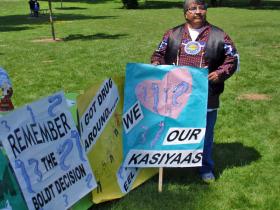
“It is not a treaty right,” State Police Captain Jeff Samuels explained. “It is definitely open to all,” with everyone under the same rules, he said of the state’s approach.
From the tribal point of view, they believe they shouldn’t need the state’s permission.
“They don’t set our seasons,” Luke said. “We have our own law enforcement that sets our own seasons.”
At Oregon’s Department of Fish and Wildlife, fishery managers are trying to finesse the issue so it doesn’t escalate. The department’s Tony Nigro said his agency is trying to reach an understanding that at least clarifies the rules.
“The state has its policies and its legal positions,” Nigro said. “They aren’t necessarily in agreement (with tribal positions) at this point in time. But we respect and recognize the differences. I think we’ve been fairly good at putting those differences aside, seeing if we can work cooperatively.”
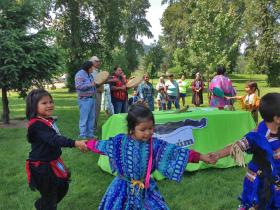
Nigro said Northwest states, tribes and the federal government have a common goal to keep Pacific lamprey off the endangered list. Populations of the migratory fish have declined dramatically in recent decades. The reasons are many including dams and water diversions. Lamprey have trouble swimming up fish ladders designed for salmon. However, both sides see room for a limited ceremonial and subsistence harvest within a larger recovery effort.
Evaline Patt, a Warm Springs tribal council member, said lamprey used to be a staple in the diets of Columbia and Snake River basin tribes.
“It’s a rare treat now,” she said, “It’s getting to be a delicacy.”
Patt compared lamprey to oysters. Others said it tastes like fishy steelhead.
Vancouver City Council Votes 5-2 To Oppose Northwest’s Largest Oil Terminal
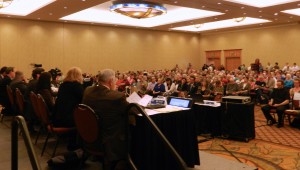
By Cassandra Profita, OPB
Monday night had turned to Tuesday morning by the time the Vancouver City Council voted to pass a non-binding resolution opposing what would be the Northwest’s largest oil-by-rail shipping facility.
The vote was 5-2 with Mayor Tim Leavitt and Councilor Bill Turlay dissenting. It followed six hours of testimony from residents, most of them opposed to the Port of Vancouver’s planned facility that would transfer North Dakota crude oil from trains to ships bound for West Coast refineries.
It was after 1 am when City Councilor Bart Hansen made a motion to pass the resolution, which expresses deep concern about rail safety, oil spills and explosions and urges Washington Gov. Jay Inslee not to approve the Tesoro Savage oil terminal.
The council debated whether or not to take the vote in the wee hours of the morning. Turlay said he wasn’t ready to take action. Leavitt said he wanted to make some changes to resolution before voting.
“I’ve been told nothing good happens after midnight,” Leavitt joked in pushing to delay the vote. “I know there are ways to improve the resolution. I hope we can get to a unanimous vote. Certainly, I’m not supportive of it as it is now.”
But other councilors pushed ahead. Councilor Anne McEnerny-Ogle said two-thirds of the testimony and comments she’s heard are from people opposed to the project.
“When I look at all the different e-mails that have come back, the voice says that for this community, this doesn’t work for us.”
Big Crowd Dwindles
By the time the board voted a crowd that had started out in the hundreds had dwindled to a few dozen.
More than 170 people signed up to testify at the hearing. At 11 p.m., more than four hours after the hearing began, the council voted to extend the meeting even later to take additional testimony. By 1 am, the council had heard from 101 people.
Even before the resolution was formally taken up, a majority of the city council had voiced opposition to the Tesoro-Savage oil terminal.
The hearing addressed two resolutions on the terminal, but most residents came to talk about the one that opposes the project as a whole. That resolution asks the Port of Vancouver to cancel its lease with Tesoro-Savage and urges state agencies and Washington Gov. Jay Inslee not to approve the project. It also supports new laws and regulations to improve crude oil transportation safety.
The council unanimously approved a resolution that calls for the city to play a bigger role in the state’s Energy Facility Site Evaluation Council review process.The council is in the midst of completing an environmental review of the project and is tasked with making a recommendation to Washington Gov. Jay Inslee, who has the final say. That resolution supports the city’s intervening in that process by presenting evidence to the state council, making arguments and appealing a decision to approve the oil terminal.
Most who testified Monday night voiced support for both resolutions and opposition to the oil terminal, although there were many who spoke on behalf of project backers Tesoro Corp. and Savage Companies.
Emotional Testimony
The resolutions drew some emotional testimony from both sides.
Don Orange, owner of Hoesly Eco-Automotive of Vancouver, told the council that he’s angry about the prospect of “thousands of pounds of filth” coming into his neighborhood and hurting his business.
“You can call this a terminal. To me, it’s a toilet,” he said. “It’s coming in here on a freight train and we’re flushing it off into ships. This small businessman thinks it stinks.”
On the other side, Port Commissioner Jerry Oliver expressed sadness that the council would consider opposing the project he thinks will benefit the country as a whole by distributing more domestically produced oil to U.S. refineries.
“It makes me sad, not so much that you’re turning your back on the Port of Vancouver, but that you have so little faith in our ability as a community to make this happen,” Oliver said.
Safety And Business Concerns Raised
The Tesoro Savage oil terminal would transport up to 380,000 barrels of crude oil a day. The oil would come from North Dakota’s Bakken fields by trains, be transferred to vessels on the Columbia River and then shipped to West Coast refineries. It’s the largest oil terminal project among the several proposed in the Northwest.
While project supporters noted that the city council doesn’t have the authority to stop the project, opponents of the project said it’s important that the city council let the governor know where it stands.
“It’s difficult to imagine the governor supporting this project if the city of Vancouver opposes it,” said Clark County resident Don Steinke after presenting the council with a box of 2,000 signatures in support of the resolutions.
Vancouver resident Carol Rose says she’s worried about safety in her community if the proposed project is built.
“It’s a tremendous amount of oil, and it’s a danger,” she says. “I’ve lived here for 40 years. I don’t want to have to move because of this.”
Many project opponents voiced concern about the risk of oil train derailments and explosions like the one that killed 47 people in Lac-Megantic, Quebec, last year.
Project supporters defended the safety record of Tesoro Corp. and Savage Companies. Earlier this year, Tesoro committed to using newer rail cars that meet higher safety standards.
Many who testified in support of the project were employees of Tesoro Corp. and Savage Companies. They told the council that they appreciate the jobs and economic development the oil terminal would bring to the area and vouched for the companies’ track records in treating their employees well.
Jared Larrabee, general manager for Tesoro, said the resolution opposing the project is premature because the Washington Energy Facility Site Evaluation Council hasn’t completed its environmental review.
“The resolution is making a predetermination without having all of the facts, in our view,” he said. “The resolution contains several inaccuracies and assertions that haven’t been validated by the forthcoming Environmental Impact Statement.”
He and other Tesoro representatives supported the resolution that would support the city intervening in the state’s environmental review process. But they urged the council to delay its vote opposing the project or to reconsider it altogether.
Todd Coleman, director of Port of Vancouver, criticized the city’s resolution and said it would damage the port’s ability to do business.
“You can’t have it both ways,” he told the board. “You can’t have a thriving port and all the things that come with that success and then attempt to choose between cargo. A vote for this resolution is a vote against this community’s ability to attract private sector business.”
Renewable Energy Takes Root In Northwest Indian Country

Courtney Flatt
By Courtney Flatt, Northwest Public Radio
PENDLETON, Ore. — You can spot one of the Eastern Oregon’s newest renewable energy projects from Interstate 84. It doesn’t look like other wind projects east of the Cascades.
A single wind turbine rises over the Tamástslikt Cultural Institute on the Confederated Tribes of the Umatilla Indian Reservation.
The turbine blades gain momentum as the wind picks up. The tribes’ executive director, Dave Tovey, said this cultural institute turned out to be the perfect spot for the first turbine erected in Northwest Indian Country. The place where the tribes broke ground for the cultural institute is notoriously windy.
“A lot of our elders would just shake their heads as say, ‘You guys know, the wind always blows up there.’ We always thought, like Indian tribes, and like we do with so many other things here, we turn a seeming disadvantage into an advantage, or even an opportunity,” Tovey said.
Many Northwest tribes have been exploring ways to get more of their electricity from renewable sources that don’t pollute, like coal-fired power plants do, or harm fish — a concern when it comes to hydroelectric dams.
David Mullon is the chief counsel for the National Congress of American Indians, based in Washington, D.C. He said renewable energy is one way tribes can protect natural resources.
“A major portion of the tribal population is located on the reservation homelands. Protecting and conserving the resources on those very small places is an important consideration,” Mullon said.
There are plenty of examples in Northwest Indian Country: Idaho’s Nez Perce Tribe and Washington’s Yakama Nation are looking into generating electricity by burning woody debris in biomass plants. The Colville Tribes in Eastern Washington get energy from biomass and solar panels, too.
In Oregon, the turbine at the Tamástslikt Cultural Institute will generate about 25 percent of the building’s electricity.
Jess Nowland helps manage the building, which serves as a gathering place and museum for the Cayuse, Umatilla and Walla Walla tribes.
Before putting up the wind turbine, the tribes were working on conservation at the center. Nowland said they’ve reduced its energy consumption by about 70 percent, saving more than $700,000.
“The reality is that there are buildings everywhere that you can achieve this kind of savings on,” Nowland said.
This wind turbine is the beginning of renewable energy on the Umatilla reservation. Next up: the tribes plans to install solar panels at the cultural institute.
Related Links:
Honoring the Legacy of Billy Frank Jr.
Being Frank is the monthly opinion column that was written for many years by the late Billy Frank Jr., NWIFC Chairman. To honor him, the treaty Indian tribes in western Washington will continue to share their perspectives on natural resources management through this column. This month’s writer is Lorraine Loomis, vice-chair of the NWIFC and fisheries manager for the Swinomish Tribe.
By Lorraine Loomis, Vice-Chairman, Northwest Indian Fisheries Commission
OLYMPIA – So much has been written and said about the passing of Billy Frank Jr., our great leader and good friend. Many people are asking how to honor Billy’s memory. Who will take his place?
One way we can honor Billy’s legacy is to carry on his work:
We must recover wild salmon to levels that can once again support harvest. That is the only true measure of salmon recovery. To do that, we must do more to protect and then to restore salmon habitat. Right now we are losing habitat faster than it can be fixed. That must change or we will continue to lose the battle for salmon recovery.
- We must maintain strong salmon hatchery programs. Most hatcheries were built to mitigate for lost natural wild salmon production caused by damaged and destroyed habitat. Tribal, state and federal hatcheries are operated safely, responsibly and using the best science to minimize impacts on wild salmon. Some hatcheries produce salmon for harvest. Others aid recovery of weak wild stocks. Every hatchery is essential to meeting the tribal treaty right by contributing salmon that are available for harvest. Without hatcheries there would be no fishing at all in most areas of western Washington. We must have hatcheries as long as wild salmon habitat continues to be degraded and disappear.
- We must achieve a more protective fish consumption rate and maintain the current cancer risk rate to improve water quality and protect the health of everyone who lives in Washington. The two rates are key factors that state government uses to determine how much pollution can be dumped in our waters. The state admits that the current fish consumption rate of 6.5 grams per day (an amount that would fit on a soda cracker) does not protect most of us who live here. It is among the lowest rates in the country, despite the fact that we have one of the largest populations of fish and shellfish consumers in the United States. Currently the cancer risk rate from toxins in seafood that the state uses to set water quality standards is one in a million, but Gov. Jay Inslee is considering a move to reduce that rate to one in 100,000, a tenfold decrease in protection. We believe Washington’s fish consumption rate should be 175 grams per day – the same as Oregon – and that the cancer risk rate should remain at one in a million.
- We must really, truly clean up Puget Sound. Every few years state government creates a new agency or cooperative effort to make that cleanup a reality. Year after year, decade after decade, we have all been working toward that goal, but we are not making sufficient progress. The main reason is lack of political will to develop and enforce regulations that could make cleanup a reality. Until that changes, the cleanup of Puget Sound will not happen.
- We must stop plans to expand the transport and export of coal and oil through our state’s land and waters. Increased oil train and tanker ship traffic and more export terminals offer nothing but problems. The likelihood of oil train explosions and derailments, along with the potential for devastating spills from tanker ships, threaten tribal treaty rights, the environment, our natural resources, our health and even our very lives. The few, mostly short-term jobs that they might provide are just not worth the cost.
- We must continue to work together on the problems we all share. We have shown that great things can be accomplished through cooperation, such as the Timber/Fish/Wildlife Agreement and the U.S./Canada Pacific Salmon Treaty. If we work together we can achieve both a healthy environment and a healthy economy. If we continue the conflict we will achieve neither outcome. A healthy environment is necessary to support a healthy economy in this region and the people who live here demand it.
Billy worked his entire life to make western Washington a better place for all of us to live. Tribal treaty rights that protect natural resources help make that possible, and benefit everyone who lives here, not just Indian tribes.
As for the question of who will pick up where Billy left off, the answer is all of us. No single person will ever be able to replace him. That’s a job for everyone. There is only one direction we can go: Forward – together – on the path Billy showed us with the teachings he shared.







